To mark the anniversary of the death of A. Sivanandan, the IRR examines how useful his ideas are for unravelling the recent turn in the UK to the concept of unconscious bias.
Until the Guardian published at the start of December 2018 its ‘findings’ of omnipresent, omnifocal ‘unconscious bias’ to explain BAME people’s lack of progression in the UK,[1] it was hard to see how far and how deeply the ‘concept’ had penetrated. Now suddenly we see the new narrative: racism is covert not overt; it is psychological not social; it is individual not structural; it is subconscious not conscious. Hence, it effectively exonerates governments, institutions, organisations, even individuals, for it is unconscious, inevitable. But it can be remedied – through retraining and therapy for the individual. Unconscious bias (UB) is the child of neoliberalism.
Just do a little googling and there are hundreds of sites now offering advice, guidance, books and courses (at a price) on UB: UB training, UB exercises, types of UB, why you can’t afford to ignore UB, UB consultancy, Understanding UB. … And there are experts – many on the psycho-social side of the academy – debating in reputable journals, especially in education and in employment, the best forms of such training or therapies.
Don’t get us wrong. We are not arguing, as the Right does, about the existence of unconscious bias. We are worried about the way it is being given primacy as the fons et origo of racism and hence (to mix a metaphor) the forge on which to hammer out racial justice.
In the beginning was the word
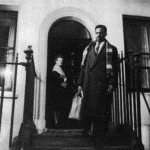
For the word or phrase matters. The word shifts blame, the word redefines, the word predicates the fight. Let’s look at it historically. One had during the 1950s and 1960s to contest the comforting use of the term xenophobia – a natural fear of strangers – which was said to explain away those ‘no Irish, no Blacks, no dogs’ signs in lodgings’ windows. Then we got ‘disadvantage’ to explain away profound racism at the hands of the police. In 1981 after the urban uprisings Lord Scarman, called in to decide what had gone wrong in the policing of Lambeth, refused to acknowledge that there was systematic racial injustice in the UK, preferring the vague term ‘disadvantage’ which attributed no cause to what black people experienced. There was suspicion and prejudice on either side of the ethnic divide. And then to counter this disadvantage we got divisive localised ‘ethnic policies’ (or poultices as Sivanandan had it to bind up the wounds of said disadvantage). And to counter prejudice we needed a raised awareness.
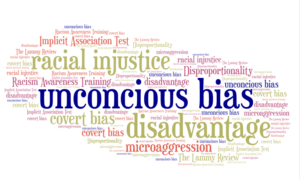 Thus, in the early 1980s we were ‘sold’ RAT (race or racism awareness training). RAT, an American import, was all the rage for dealing with prejudice and being promoted by well-meaning left-leaning local authorities – which had money at that time. The IRR with the analysis provided by Sivanandan ‘RAT and the degradation of black Struggle’[2] produced a robust critique of it and RAT appeared to die a death. For Sivanandan, RAT failed to make the distinction between personal racialism (i.e. attitude and prejudice) and institutional and state racism. Worse it imposed a kind of collective guilt on all white people (as opposed to power structures in societies) implying that they were almost programmed as of birth to be racists. Trying to bridge the analytical gap between individuals and social forces, RAT practitioners adopted the very lazy idea that racism was simply prejudice + power (power being individualised to white professionals). The critique went on to parody the training of people out of racialist attitudes as teaching people to excrete their shit genteelly – letting the guilt out.
Thus, in the early 1980s we were ‘sold’ RAT (race or racism awareness training). RAT, an American import, was all the rage for dealing with prejudice and being promoted by well-meaning left-leaning local authorities – which had money at that time. The IRR with the analysis provided by Sivanandan ‘RAT and the degradation of black Struggle’[2] produced a robust critique of it and RAT appeared to die a death. For Sivanandan, RAT failed to make the distinction between personal racialism (i.e. attitude and prejudice) and institutional and state racism. Worse it imposed a kind of collective guilt on all white people (as opposed to power structures in societies) implying that they were almost programmed as of birth to be racists. Trying to bridge the analytical gap between individuals and social forces, RAT practitioners adopted the very lazy idea that racism was simply prejudice + power (power being individualised to white professionals). The critique went on to parody the training of people out of racialist attitudes as teaching people to excrete their shit genteelly – letting the guilt out.
Behind the critique of RAT lay the notion that one has to distinguish between attitudes, which of themselves may not affect anyone, the acting out of those attitudes, which is discrimination, and the imprimatur of the state in creating the conditions for and condoning of racism. The need to make these distinctions is because we need to know where to conduct the fight.
 But then in 1999 came the Macpherson report into the 1993 death of Stephen Lawrence in a racist street attack and subsequent police enquiry. And Macpherson, pushed no doubt by the weight of the evidence put before him, came out with a finding of institutional racism in the police and by implication in other agencies and structures. And the fact that this was said in a government-backed report (whatever the muddled thinking in his extended description of it[3]) was a watershed.
But then in 1999 came the Macpherson report into the 1993 death of Stephen Lawrence in a racist street attack and subsequent police enquiry. And Macpherson, pushed no doubt by the weight of the evidence put before him, came out with a finding of institutional racism in the police and by implication in other agencies and structures. And the fact that this was said in a government-backed report (whatever the muddled thinking in his extended description of it[3]) was a watershed.
From Macpherson to Lammy
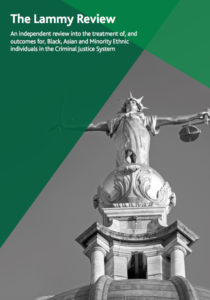 It was what groups and organisations fighting police brutality and racist violence for years had waited to have acknowledged as official fact. But it was just not what the police or the establishment wanted to hear. And since 1999 there has been a rear-guard action from right-wing politicians and the police to somehow wipe institutional racism from national consciousness,[4] – not the reality on the ground, you understand, but the concept. That this was now entering the mainstream became quite evident in the 2017 Lammy Review ‘into the treatment of, and outcomes for, Black, Asian and Minority Ethnic individuals in the Criminal Justice System’.
It was what groups and organisations fighting police brutality and racist violence for years had waited to have acknowledged as official fact. But it was just not what the police or the establishment wanted to hear. And since 1999 there has been a rear-guard action from right-wing politicians and the police to somehow wipe institutional racism from national consciousness,[4] – not the reality on the ground, you understand, but the concept. That this was now entering the mainstream became quite evident in the 2017 Lammy Review ‘into the treatment of, and outcomes for, Black, Asian and Minority Ethnic individuals in the Criminal Justice System’.
As Liz Fekete pointed out:
Having failed to mention institutional racism in the body of the report, Lammy identifies, in his conclusion, three forms of prejudice – ‘overt, covert and unconscious’ – as fault lines within the CJS. Many newspapers flagged up issues of ‘racial bias’ in reporting the publication of the Lammy review, but there is but one reference to racial bias in the report, where Lammy much prefers to work with phrases like ‘unintended bias’, ‘unconscious’ or ‘implicit bias.[5]
Racism as microaggression and covert bias
But the swing of the pendulum from institutional racism to unconscious bias is not just a concession to the anti-Macpherson Right; it has at least two other contributing nudges. On the one hand in the UK, we have had over the last two or three years a series of popular books[6] by BAME authors stressing the ubiquity of everyday racism, microaggressions, witnessed in a range of experiences from being mistaken for someone else, names forgotten, a culture which excludes people who look like them, a school curriculum which skews the historical record, to being passed over for jobs. This all-pervasive racism (personal, cultural, structural, representational) is explained by the concept of ‘white privilege’. This they maintain is because of racism’s deep penetration everywhere including into white people’s consciousnesses, so that it inevitably colours interactions. White people think they are ‘colour-blind’ when in fact they practise forms of covert racism all the time. (Theoretically they are borrowing from Critical Race Theory [7] and the work of Eduardo Bonilla-Silva.[8])
Importing IAT

On the other hand, or perhaps it is one and the same, changes in naming the problem in the US were slowly seeping into the British vernacular. And the US experience was particular. With the election of president Obama in 2008, a black man in the highest position in the land, it became part of the national narrative to describe the US as post-racial. And to fight this illusory idea that one black swallow made an egalitarian summer of a country based on slavery, people began to stress the omnipotence of everyday racism felt by the majority of the ‘Land of the Free’s inhabitants. And experts and professionals, especially in the fields of law, education and employment, had recourse to ‘science’ to validate and measure their claims. And they lighted on the ‘magic bullet’ of the Implicit Association Test (IAT) – basically a social cognition test – devised in 1998 by three psychologists,[9] to prove their point. Via its now accessible and online portal it purports to show, by giving an individual a series of images to choose between, how deeply in our subconscious we may hold views of ‘the other’, despite our conscious wish to be just. This test or its variants are now being used extensively to counter disproportionality in various professions in recruitment and promotion policies. (It was, too, given prominence in the Guardian’s take on racism and bias.)
Disproportionality – usually showing the under-representation of a particular group in an area or profession compared with their number in the population – is now a very popular way of ‘proving’ racism – vide the Guardian. But, as Lee Bridges pointed out in his critique of the Lammy Review, what it actually gives is a snapshot of something at one stage in a system. If, as Lammy was, we are looking for causes, we have to look at the way that stages compound one another and fit into whole processes. And the disproportion snapshots do not allow for such analyses.[10]
The problem with IAT and bias ‘theory’
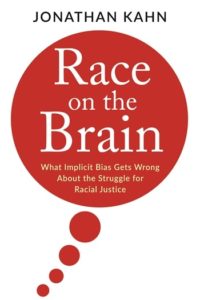 US law professor Jonathan Kahn in his book Race on the Brain: what implicit bias gets wrong about the struggle for racial justice[11] explicates the political problems when ‘implicit bias’ morphs ‘from a useful psychological theory of cognitive function into a master narrative framing legal and policy response to race and racism in America today’. To provide a resume of his arguments:
US law professor Jonathan Kahn in his book Race on the Brain: what implicit bias gets wrong about the struggle for racial justice[11] explicates the political problems when ‘implicit bias’ morphs ‘from a useful psychological theory of cognitive function into a master narrative framing legal and policy response to race and racism in America today’. To provide a resume of his arguments:
it denies history;
it reduces racism to merely another form of ‘bias’;
it obscures power relations which undergird contemporary race relations;
it promotes a mirage of an easy pain-free way to fight racism;
it is overenthusiastic about a technological fix for what is fundamentally a complex social, political and historical problem;
it opens the door to the biologicalisation of racism. (An Oxford research team is said to have come up with a drug to counter implicit bias!)[12]
Looking specifically at the UK, where does the emphasis on ‘bias’ take the struggle against racism? Yes, as implied throughout this piece, it moves the centre of gravity from institutions and structures to the individual and, unfortunately, to the unconscious. But this has profound implications – in terms of class and hence what to fight and how to fight. It may feel from the point of view of those coming up against the ‘glass ceiling’, that racism is simply ubiquitous but that does not mean that it does not affect different groups and classes differentially. Everyday microaggressions, though wearing and demoralising, are not the same as a death in custody, a deportation or a housing eviction. We have, as Sivanandan pointed out, to distinguish between ‘the racism that kills’ and ‘the racism that discriminates’ especially when austerity policies and neoliberalism are making for an ever-increasingly unequal society.
And pinning one’s star to just enlarging the number of BAME people in an organisation or structure does not of itself change that organisation’s policies – witness Sajid Javid.[13] (Changing the colour of those in charge does not ipso facto change the colour of the policies.) And structural racism is not just as a recent writer had it, ‘the intensification of personal prejudice, of groupthink’.[14] The Home Office has racist policies on terrorism, security, immigration, gangs, all determined not by nasty unenlightened people but by state policies, themselves influenced by economics and foreign policy. [15]
The emphasis on individual bias runs fundamentally against a materialist view of society. It puts the chicken before the egg. Do ‘white’ attitudes and biases create the discrimination that blights the lives of BAME people? Or are those biases being inculcated and constantly being redefined by the political culture around us, itself being reproduced by the laws of the land, the steers from the media, and in fact the larger processes of globalisation and its flipside austerity – which provide the wrapper for class and power relations?


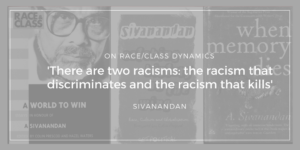
Thank you. This is so clearly written. Siva’s legacy and the work of IRR is needed more than ever. I will include this in my reading lists for students.
Jenny, not only do you energetically sweep away current RAT droppings, but you do so with Siva’s holistic grasp and, at times, cadence…excellent job!
Jenny,
What passion for justice and poetry in your language! …
“In the beginning was the word
For the word or phrase matters.
The word shifts blame, the word redefines, the word predicates the fight. Let’s look at it historically.”
Indeed fitting and great way to remember Siva and mark the anniversary of his passing.
Excellent, Jenny. Thank you. Clear, concise and, as ever, wonderfully written. Love and comradeship. Phil x
Jenny, this is a wonderful tribute to Siva’s thinking and legacy but also a great piece of itself: historically-based, punchy, direct, completely jargon-free, unanswerable in argument, as clear as crystal. What a great way to mark the anniversary.
Great article Jenny. As a social psychologist, I find it frustrating how the Guardian and BBC, rather than survey the several explanations within the social psychologies of racism and prejudice, picked out one, highly individualistic explanation, ‘unconscious bias’ and ran with it. Its not just that there are structural and institutional explanations, there are undoubtedly better social psychological explanations and ways forward. It seems like a case of ‘their particularisation will be our generalisation’ – I’m glad you challenged it.
Thank you Jenny for an excellent, clear piece of writing. An apt tribute to Siva but also a stand alone piece.
In my opinion on “ unconscious bias “ true it is in my believe that as a child you hear what your parents say, without taking into account what was said. As a child for example, I always heard how the white people came to Hawaii & took over our land.
They described things by the color of their skin without thinking. I did not think it was racist or we were discrimming against them , it was a way to describe them. I didn’t realize it was being labeled .
I believed “ Racist or discrimination” is a word created & by bringing up makes things makes it worse than they really are! Too much attention is crating turmoil in this world of outs!
Correction too much turmoil is creating the problems in this world of ours. Making people aware of the unconscious bias is it really going to improve the problems that’s already there? In my opinion it is just making people more riled up instead of calming them down. Do you really believe Publishing that would it make everyone stop and think before they say another word how one really feels, Hopefully.
If you know and aware that it’s “unconscious bias” of your reaction and your thoughts, but to improve the next generation start there by not bringing attention to that because you as a parent have already made a comment published it and what will your child think ? Meghan & Harry brought that subject up because the were brought up to be aware of it & they want the public to be aware too! So give it a clean slate and live by example and do the things that you think you don’t want your child to live by.
Your child is already in this world of Turmoil and how are you going to protect him from that?
It sounds like what is required is some kind of cultural revolution where we gives the reins of power to those who have studied critical race theory for a while to allow them to recreate a post-racial society? Where all micro-aggressions can be ironed out, nobody forgets anyone’s name, no-one is ever excluded, the curriculum teaches the “correct” version of history, all laws are written in such a way that produces equal outcomes for all groups, the white people have felt guilty enough for long enough, power relations are perfectly equal and, at the same time, proportional to population in all contexts and the innocent will finally be free of all oppression.
Thanks for this detailed debunking of ‘unconscious bias’ and highlighting the deeply unsatisfying nature of the Lammy review. Breath of fresh air.
this is really good but it relies on “neoliberalism” as if that can even be clearly defined. I agree with the author but using the “all roads lead to neoliberalism” thesis is perhaps as nebulous as using “unconscious bias” to diagnose race dynamics. It signals to all of us who “know” what is going on but doesn’t do much to describe the real situation
Very funny watching ‘Emmerdale’ on TV last night conveying the concept of unconscious bias with virtuous black characters explaining to equally virtuous , but white, characters the non-innocence of their ways. Very clunky and essentialist!